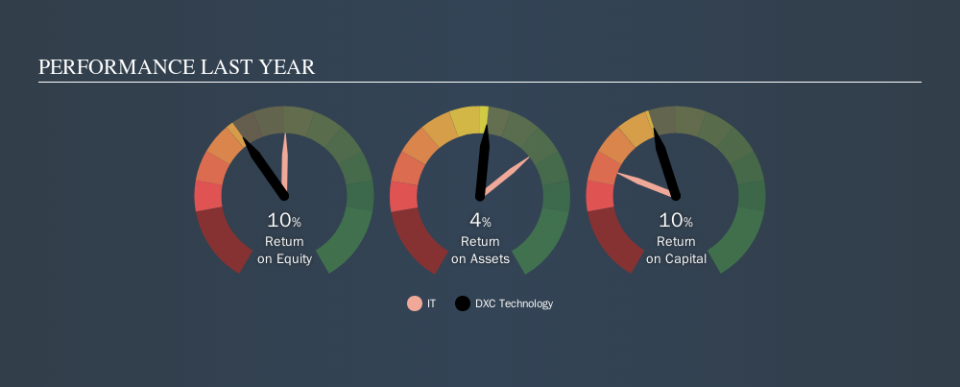How Good Is DXC Technology Company (NYSE:DXC) At Creating Shareholder Value?

Today we'll evaluate DXC Technology Company (NYSE:DXC) to determine whether it could have potential as an investment idea. Specifically, we're going to calculate its Return On Capital Employed (ROCE), in the hopes of getting some insight into the business.
First, we'll go over how we calculate ROCE. Then we'll compare its ROCE to similar companies. Last but not least, we'll look at what impact its current liabilities have on its ROCE.
What is Return On Capital Employed (ROCE)?
ROCE is a metric for evaluating how much pre-tax income (in percentage terms) a company earns on the capital invested in its business. All else being equal, a better business will have a higher ROCE. Ultimately, it is a useful but imperfect metric. Renowned investment researcher Michael Mauboussin has suggested that a high ROCE can indicate that 'one dollar invested in the company generates value of more than one dollar'.
How Do You Calculate Return On Capital Employed?
Analysts use this formula to calculate return on capital employed:
Return on Capital Employed = Earnings Before Interest and Tax (EBIT) ÷ (Total Assets - Current Liabilities)
Or for DXC Technology:
0.099 = US$2.3b ÷ (US$33b - US$9.3b) (Based on the trailing twelve months to June 2019.)
Therefore, DXC Technology has an ROCE of 9.9%.
View our latest analysis for DXC Technology
Does DXC Technology Have A Good ROCE?
ROCE can be useful when making comparisons, such as between similar companies. Using our data, DXC Technology's ROCE appears to be around the 10% average of the IT industry. Aside from the industry comparison, DXC Technology's ROCE is mediocre in absolute terms, considering the risk of investing in stocks versus the safety of a bank account. It is possible that there are more rewarding investments out there.
In our analysis, DXC Technology's ROCE appears to be 9.9%, compared to 3 years ago, when its ROCE was 3.8%. This makes us wonder if the company is improving. You can see in the image below how DXC Technology's ROCE compares to its industry. Click to see more on past growth.
Remember that this metric is backwards looking - it shows what has happened in the past, and does not accurately predict the future. Companies in cyclical industries can be difficult to understand using ROCE, as returns typically look high during boom times, and low during busts. ROCE is only a point-in-time measure. What happens in the future is pretty important for investors, so we have prepared a free report on analyst forecasts for DXC Technology.
What Are Current Liabilities, And How Do They Affect DXC Technology's ROCE?
Short term (or current) liabilities, are things like supplier invoices, overdrafts, or tax bills that need to be paid within 12 months. The ROCE equation subtracts current liabilities from capital employed, so a company with a lot of current liabilities appears to have less capital employed, and a higher ROCE than otherwise. To counteract this, we check if a company has high current liabilities, relative to its total assets.
DXC Technology has total liabilities of US$9.3b and total assets of US$33b. Therefore its current liabilities are equivalent to approximately 29% of its total assets. It is good to see a restrained amount of current liabilities, as this limits the effect on ROCE.
What We Can Learn From DXC Technology's ROCE
That said, DXC Technology's ROCE is mediocre, there may be more attractive investments around. Of course, you might also be able to find a better stock than DXC Technology. So you may wish to see this free collection of other companies that have grown earnings strongly.
I will like DXC Technology better if I see some big insider buys. While we wait, check out this free list of growing companies with considerable, recent, insider buying.
We aim to bring you long-term focused research analysis driven by fundamental data. Note that our analysis may not factor in the latest price-sensitive company announcements or qualitative material.
If you spot an error that warrants correction, please contact the editor at editorial-team@simplywallst.com. This article by Simply Wall St is general in nature. It does not constitute a recommendation to buy or sell any stock, and does not take account of your objectives, or your financial situation. Simply Wall St has no position in the stocks mentioned. Thank you for reading.

 Yahoo Finance
Yahoo Finance 
